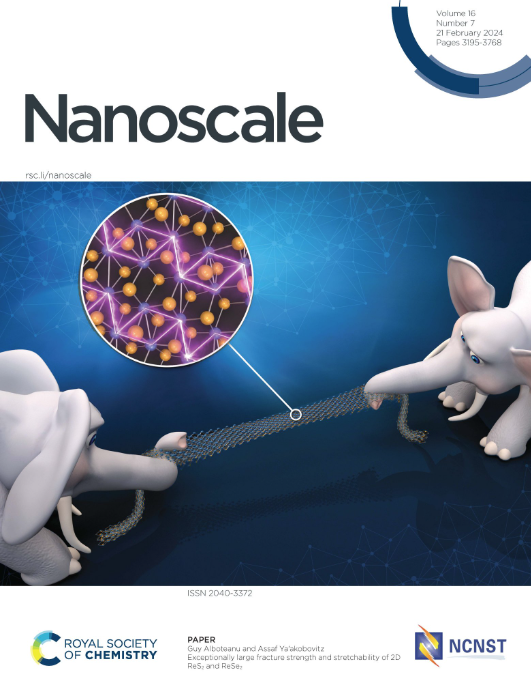NiFeMo layered triple hydroxide and MXene heterostructure for boosted oxygen evolution reaction in anion exchange membrane water electrolysis
IF 5.8
3区 材料科学
Q1 CHEMISTRY, MULTIDISCIPLINARY
引用次数: 0
Abstract
Efficient, low cost and stable electrocatalysts are highly desirable for sluggish oxygen evolution reaction (OER) in alkaline water electrolysis for hydrogen production. Interfacial engineering of heterostructures is quite beneficial for improving charge transfer efficiency at the interface. In this context, heterostructures of layered triple hydroxides (LTHs) and MXenes have shown great potential for OER electrocatalysts owing to their 2D-2D structure and unique physiochemical properties. Coupling LTHs with MXenes can potentially enhance their conductivity and stability, thereby boosting OER activity. In this study, we report a heterointerface between NiFeMo-LTH on Ti3C2Tx MXene, which exhibits superior catalytic activity and stability in alkaline freshwater as well as seawater reducing the activation energy. Importantly, the heterostructure achieved a current density of 100 mA cm-2 at by the cost of 292 mV and 340 mV overpotentials in alkaline saline water and real seawater, respectively and showed robustness over 100 h without any hypochlorite formation causing corrosion in alkaline real seawater. Moreover, NiFeMo-LTH/MXene was also explored in alkaline anion exchange membrane water electrolyzer (AEMWE) achieving a current density of 750 mA cm-2 at 2.16 V cell voltage at operating temperature of 60 ⁰C with energy efficiency of 60.5%. The Raman analysis and XPS analysis post stability test demonstrates the easy electron transfer from LTH to MXene at heterointerface leading to formation of NiOOH electroactive species facilitates the OER activity.NiFeMo层状三氢氧化物和MXene异质结构在阴离子交换膜电解中促进析氧反应
高效、低成本、稳定的电催化剂是碱水电解制氢过程中缓慢析氧反应(OER)的理想催化剂。异质结构的界面工程对于提高界面上的电荷传递效率是十分有利的。在这种情况下,层状三氢氧化物(LTHs)和MXenes的异质结构由于其2D-2D结构和独特的物理化学性质而显示出巨大的OER电催化剂潜力。LTHs与MXenes的耦合可以潜在地增强其导电性和稳定性,从而提高OER活性。在本研究中,我们报道了NiFeMo-LTH在Ti3C2Tx MXene上的异质界面,在碱性淡水和海水中表现出优异的催化活性和稳定性,降低了活化能。重要的是,异质结构在碱性盐水和真实海水中分别以292 mV和340 mV过电位为代价获得了100 mA cm-2的电流密度,并且在碱性真实海水中表现出100 h的稳健性,没有任何次氯酸盐形成导致腐蚀。此外,NiFeMo-LTH/MXene还在碱性阴离子交换膜水电解槽(AEMWE)中进行了探索,在2.16 V电池电压下,在60⁰C的工作温度下实现了750 mA cm-2的电流密度,能量效率为60.5%。拉曼分析和XPS分析后稳定性测试表明,在异质界面上,电子容易从LTH转移到MXene,导致NiOOH电活性物质的形成,从而促进了OER活性。
本文章由计算机程序翻译,如有差异,请以英文原文为准。
求助全文
约1分钟内获得全文
求助全文
来源期刊

Nanoscale
CHEMISTRY, MULTIDISCIPLINARY-NANOSCIENCE & NANOTECHNOLOGY
CiteScore
12.10
自引率
3.00%
发文量
1628
审稿时长
1.6 months
期刊介绍:
Nanoscale is a high-impact international journal, publishing high-quality research across nanoscience and nanotechnology. Nanoscale publishes a full mix of research articles on experimental and theoretical work, including reviews, communications, and full papers.Highly interdisciplinary, this journal appeals to scientists, researchers and professionals interested in nanoscience and nanotechnology, quantum materials and quantum technology, including the areas of physics, chemistry, biology, medicine, materials, energy/environment, information technology, detection science, healthcare and drug discovery, and electronics.
 求助内容:
求助内容: 应助结果提醒方式:
应助结果提醒方式:


